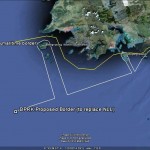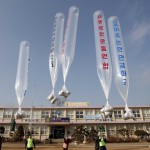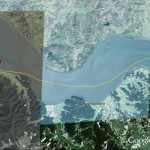
Pictured above (Google Earth): The NLL and the DPRK’s alternative maritime border in the West Sea
Evan Ramstad writes in the Wall Street Journal:
North Korea state media on Thursday issued a statement that claimed possession of all waters around South Korea-controlled Yeonpyeong Island, clarifying for the first time that its Nov. 23 attack of the island was motivated by a different view of the inter-Korean maritime boundary in the Yellow Sea than is widely held.
North Korea has said since the attack that it was motivated because shells from an artillery test South Korea conducted on the island that day fell into its waters.
Military officials in South Korea have said that its test-firing that day was routine and was directed into South Korean waters south of the island. South Korea has long understood the maritime boundary to be in several miles north of the island and, as a result, directs its tests southward.
But officials and analysts who have watched North Korea’s evolving statements since Nov. 23 have noticed that Pyongyang didn’t claim that South Korea fired northward, raising questions about just what territory North Korea was claiming.
The new statement carried by Korea Central News Agency wiped out the ambiguity.
“The above-said island is located deep inside the territorial waters of the DPRK side from the maritime demarcation line,” the statement said, using an acronym for North Korea’s full name, the Democratic People’s Republic of Korea.
“If any live shell firing is conducted from there, shells are bound to drop inside the territorial waters of the DPRK side no matter in which direction they are fired because of these geographical features of the island,” the statement added.
North Korea has long disputed the inter-Korean maritime border in the Yellow Sea, or West Sea, which was drawn up by the United Nations when hostilities in the Korean War ended with a ceasefire in 1953.
In recent years, North Korea has grown more vocal and belligerent in its claim of a different maritime border, one that runs many miles to the south of the one drawn by the U.N. and known in South Korea as the Northern Limit Line, or NLL.
In North Korea’s claim, five islands that have long been controlled by South Korea lie within its waters. However, North Korea has not claimed possession of the islands.
As it exists, the U.N.-drawn border forces military and fishing vessels from the North Korean city of Haeju and other points along its southern coast to make a coastline-hugging journey westward for 30 miles or more before they can reach open water.
Here is the DPRK’s statement in full from the new KCNA page (for those who do not want to visit the new page):
Pyongyang, December 9 (KCNA) — The Secretariat of the Committee for the Peaceful Reunification of Korea released a detailed report on Wednesday laying bare the truth and nature of the Yonphyong Island shelling incident in the West Sea of Korea. It clarified internally and externally who was the provocateur and who was to wholly blame for it.
The report said:
The Yonphyong Island covers just 6.8 square km and it has nearly 18 km in circumference. But this small island has been fortified as such core military stronghold that the puppet forces call it “area for top class guard.” A brigade of the puppet marine corps and “K-9” self-propelled artillery pieces of more than one company are deployed on the island and it has a dense network of detection means and intelligence-gathering and communication facilities.
It was waters not far from Yonphyong archipelago that patrol ship of the puppet forces “Cheonan” sank in March this year. The puppet warmongers have persistently escalated the tension in this area, crying out for seeking “revenge,” and at last went the lengths of perpetrating direct shelling under the pretext of a military exercise.
The motive of the incident and the background against which it occurred make it clearer that it was a deliberate provocation of the puppet forces.
The above-said island is located deep inside the territorial waters of the DPRK side from the maritime demarcation line. If any live shell firing is conducted from there, shells are bound to drop inside the territorial waters of the DPRK side no matter in which direction they are fired because of these geographical features of the island.
The puppet warmongers fired as many as thousands of shells into the territorial waters of the DPRK side after deliberately fixing those waters as a target of sighting firing. This reckless act was obviously a deliberate provocation to prompt the DPRK to take a military counter-action.
No matter what rhetoric the south Korean conservative group may use in a bid to shift the responsibility for the incident onto the DPRK like a thief crying “Stop the thief!” it cannot hide the truth.
The above-said incident was an inevitable product of the puppet conservative group′s vicious moves to escalate the confrontation with fellow countrymen and ignite a war.
The inter-Korean dialogues and visits which had been brisk since the adoption of the June 15 joint declaration were totally suspended and an atmosphere of reconciliation, unity and reunification rapidly got cool due to the puppet group.
The conservative authorities of south Korea have persistently mocked at the DPRK′s sincere efforts to improve the inter-Korean relations and turned away their faces from them.
Since the puppet warmongers′ seizure of power, they have staged an increasing number of exercises for a war of aggression against the DPRK and they assumed more dangerous nature.
They have staged more frequent military exercises in waters off Yonphyong Island, in particular.
When the puppet group′s all policies to escalate the confrontation with the DPRK and war moves against it proved totally bankrupt in face of the domestic and foreign public′s rebuff and condemnation, it orchestrated such hideous shocking incident as the Yonphyong Island shelling incident as its last-ditch effort.
While the conservative group of south Korea was the direct provocateur of the said incident, the U.S. was a wire-puller and chieftain of the incident as it egged the puppet warmongers onto the military provocation.
The above-said incident was triggered off because of the illegal “northern limit line” fixed by the U.S. in the West Sea of Korea.
Military clashes and disputes have not ceased in waters of the West Sea of Korea since the cease-fire due to this bogus line having no ground in the light of international law as it was unilaterally drawn by Clark, the then UN forces commander on August 30, 1953.
The U.S. sidestepped the DPRK′s fair and aboveboard proposal for fixing a military boundary line in the West Sea. And it instigated the puppet conservative group to totally scrap the June 15 joint declaration and the October 4 declaration, claiming that the setting up of a special zone for peace and cooperation in the West Sea would bring the “northern limit line” to naught.
The U.S. in league with the puppet warmongers have run the whole gamut of schemes to make the “northern limit line” an established fact at any cost.
Not only the warship “Cheonan” case in March but the recent Yonphyong Island shelling incident were cooked up according to this sinister scenario of the U.S. and under its backstage manipulation.
Since the above-said shelling incident the U.S. has massively supplied the latest weapons to the puppet group while zealously egging it onto carry out what it called “retaliation plan.” This fact goes to clearly prove that the U.S. was the arch criminal who orchestrated and wire-pulled the incident behind the scene.
Additional Information:
1. I have been keeping up with the Yonpyong shelling saga here.
2. Google Earth/Maps now has high resolution imagery of Yongpyong and the DPRK peninsula where the attack originated. Check it out at 37°39’44.04″N, 125°42’9.71″E and 37°46’21.28″N, 125°36’16.97″E
3. Sorry, Josh, no “Brigandish” this time. Josh Stanton (One Free Korea) gets credit for inventing the KCNA drinking game. Every time KCNA mentions “Brandish” behavior, you take a drink. For those who like to imbibe more frequently, here is a link to every single KCNA story that mentions “Briganish”–all 738 of them. This is courtesy of the indispensable STALIN search engine.
Read the full Wall Street Journal story here:
North Korea Claims Waters Around Shelled Island
Wall Street Journal
Evan Ramstad
12/8/2010



